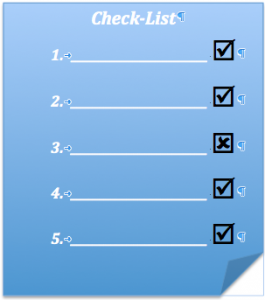Why would you care, and get tired for what isn’t worth ?
You can easily get lost when you take anything and everything into consideration while you want to manage, consider risks and protect your information. You should concentrate on the essential.
This essential is defined by answering 5 questions on your important information. All other tasks will be simplified.
Your “Top 3, 5 or 10” information
It’s the corner stone of all your moves. You should identify your key information. Depending on your situation and your activities, you’ll identify the 3, 5 or 10 most important ones. It’s probably the most difficult move to make, as you have to make a choice.
This choice is potentially subjective and will be affined later on. I’ve already encountered situations where part of this list is rejected during the subsequent activities, and other information added.
Examples:
- your clients’ list
- your accounting file
- your production secrets
- your family or personal secrets
- your family records
- your medical file
The following questions are concerned with this list of information.
The 5 questions
The utility and use
What is the purpose of the information? Why do you need it? What are you doing with it?
It’s the starting point of the list of tasks, procedures and processes you daily perform.
As for now, identification of these aims and activities suffices.
It’s during the risk management that you’ll look for what you don’t want to happen.
The source
Where does this information come from?
It can be you
- you are creative and have a lot of imagination
- you’ve treated information in your hands.
It can be anywhere else: other persons, books or media.
You should identify these sources to determine their level of trust… and the associated risks.
The actor
Who’s dealing with this information? It’s frequently you or a co-worker: family, colleague, employee or others such as a computer program.
You should, here too, identify these actors to determine their level of trust… and the associated risks.
The addressee(s)
Who will receive the result of your activity – which is always information in a form or another?
You should sufficiently know the addressee to precise the format and the structure (s)he’s expecting… and perceive what it’ll cost you if (s)he isn’t happy.
The communication channels
From the source to the used resources, between the used resources, from the used resources to the addressee, we use communication channels to transport the information.
You should know and understand these channels to use the best adequate one and the best protocol… and identify the risks linked with their use.
Communication protocols are signals, formats and back-and-forth moves similar to these used in politeness between persons and that ensures that the message is correctly got through.
And now?
You now dispose of a complete summary description of the information that, in your own eyes, is important to you.
You directly see that mixing this information will create a lot of difficulties. You should then file the information (potentially in different files or memory disks on your computer).
After, you classify the information. I repeat that’s only using a technique to measure the value of information along axes you define as important to you. You’ll see, then, that it will become far less subjective.
It remains to manage the information, to manage its risks, and you’ll know what to do to protect it ‘adequately’.
I think it was necessary to come back, with a different angle of view, on the approach to be taken to effectively act and eventually protect your valuable information.
Have you put this into action? How do you feel now?
See you soon, more secure with your information.
Jean-Luc
Google+
